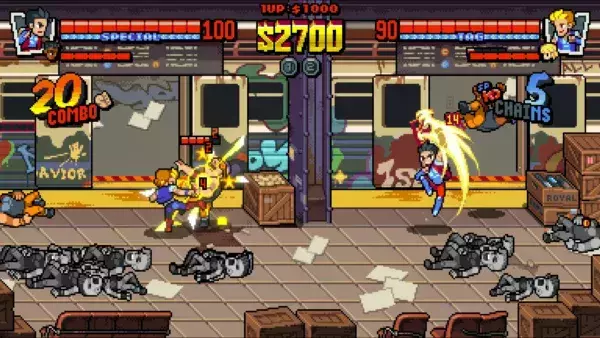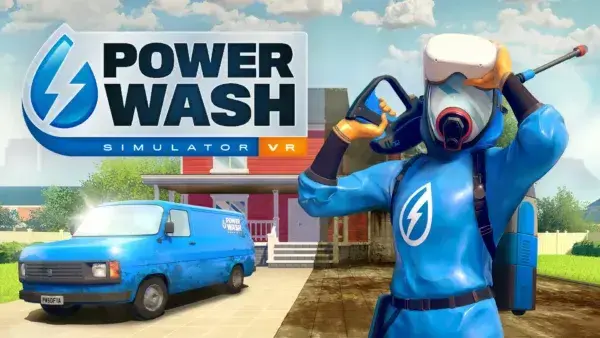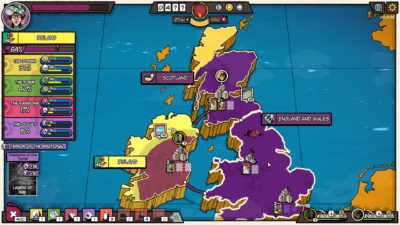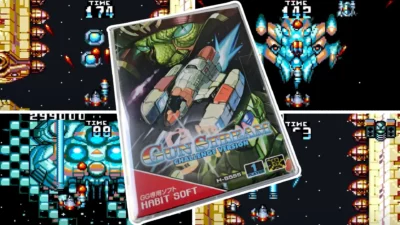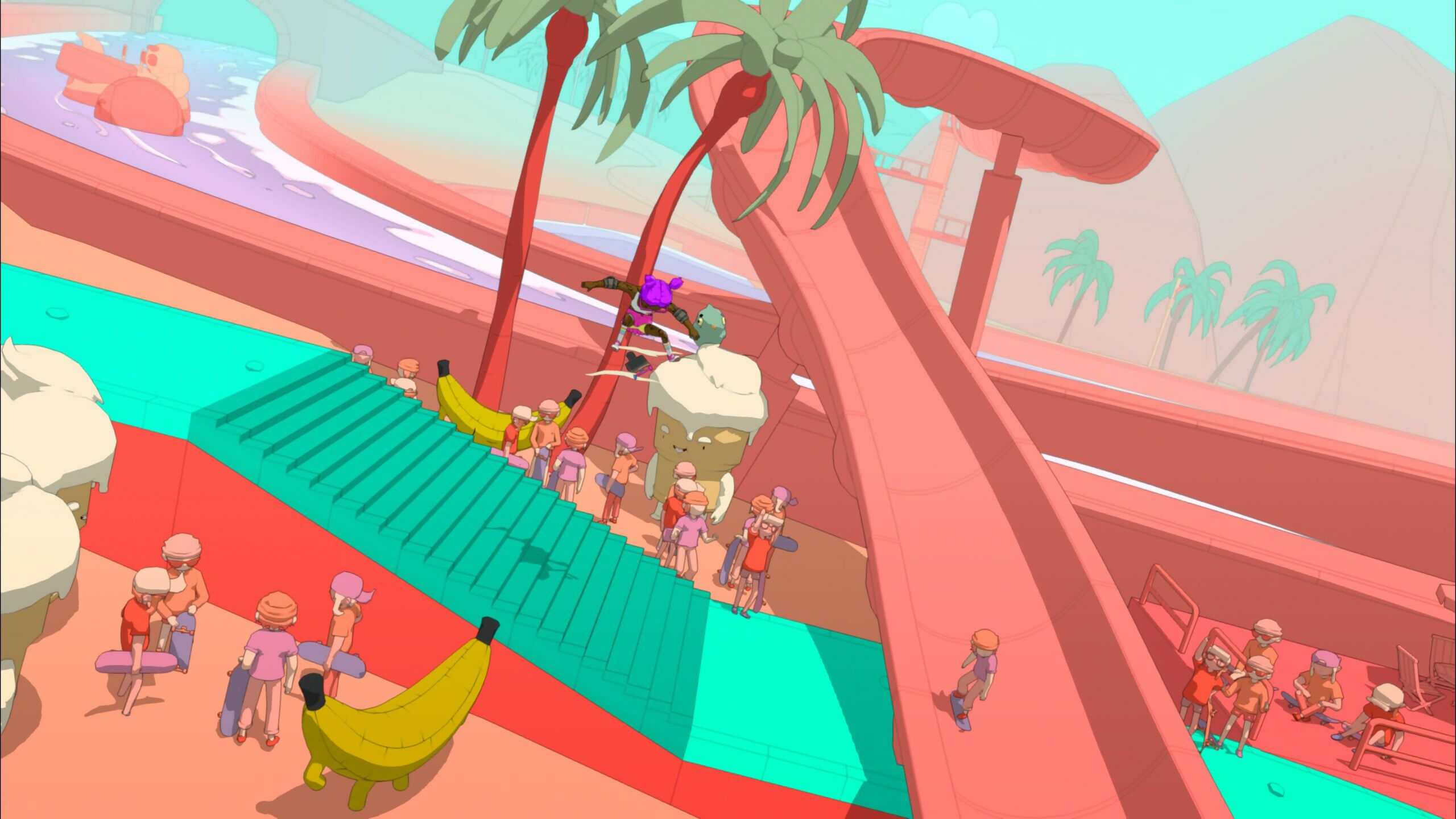
OlliOlli World’s developer Roll7 wants its game to be accessible. The previous two titles in the series, OlliOlli and OlliOlli2: Welcome to OlliWood, were exceptionally well-crafted slices of hardcore finger dexterity, requiring timing and reactions to be tip-top in order to skate your way through their lo-fi worlds. Both were excellent games, capable of instilling a sense of Zen-like calm as you ran through another flawless combo… but both were also difficult games, where hitting that flawless combo just wasn’t something everyone could do, and making a small mistake resulted in the sort of penalising that puts people off continuing to play.
So it’s understandable that the UK-based studio wants its third skateboarding game to bring more players into the fold and help us all engage with that ‘flow state’ we hear so much about. OlliOlli World brings more carrot than stick this time around, opting to encourage and reward rather than penalise and deride, all while being just as technical and skilful as before.
But OlliOlli World isn’t just about bringing more players on board – it’s bringing in more character, too. The clue’s in the title, as you’d expect, with a whole world of colour and exploration to be uncovered in the game’s location, Radlandia – a far cry from the functional-but-lacking-pizazz approach of the first two games.
Players work through a storyline with a fully customisable character, meeting and engaging with plenty of other colourful characters along the way, including new favourite BB Hopper, a business frog.
And, frankly, the game plays really well too. It manages to bring along that sense of skill and mastery from the series’ history, while blending in a more welcoming approach – you’re slowed down rather than outright failed if you don’t quite nail things, for example. High-level players should still be catered for, too, so this genuinely doesn’t feel like anything other than a win-win.
With a desire to find out more, we had a chat with Roll7’s co-CEO, Tom Hegarty, and creative director, John Ribbins.
You’re on a 2D plane, but that doesn’t stop the 3D from making itself known at times – especially when switching routes.
Where did the idea for OlliOlli World come from?
JR: After OlliOlli2, we were like, ‘No more skateboarding games ever, thank you’, and then obviously we did Laser League. We had a bit of a break, prototypes, lots of ideas – I think we learned an awful lot in the years following OlliOlli2. I think we realised, being honest, OlliOlli is probably the best game we’ve ever made and actually, it’s very dear to us. And there were a lot of tweets – the tweets going ‘When’s OlliOlli 3 happening?’ never went away. Over that period of time we learned a lot more, we got a lot better at making video games, and we were able to be a bit more critical of the games we made.
We thought even though it reviewed well, and people really enjoyed it, if we had another crack at it we could do a much better job making a much more accessible game. Over 2018 especially, I think we all coalesced around this idea that we could make a really good third OlliOlli. And it started to grow from there, delving more into the illustrative art style, trying to make the game more welcoming – how we could have this idea of multiple paths in a 2D world, all of those sides coming together, and we got really excited about it. Then we had to start running around trying to find a partner for it, because we really, really wanted to make it.
How do you design something to feel right? How do you nail that flow state you talk about?
TH: Watching people talk about the first two games, we had some amazing reviews, amazing feedback, people talked about them really fondly. But you had people that went, ‘I can’t play this game, it’s just it’s too difficult’. And that was quite sad. So when John talks about making it more approachable, we wanted to kind of remove that skill wall because the people who enjoyed it and got into the flow, which is so important for us, those people were having a great time. So we wanted more people to get to that flow. We looked at the edges we needed to smooth, what we could do that didn’t affect the core gameplay, so people who loved it before still love it. What things we could remove to bring more people in, but keeping that high ceiling of skill and mastery.
JR: Tom says, ‘We’re gameplay first as a studio’, right? The central toy at the core of the game has to be fun… We prototyped all of our games extensively; we’ve prototyped this game for like, a year. So that initial ‘finding the feeling’ before you can hide anything behind snazzy graphics or nice VFX or even sound design or animation – just that the very core of it feels good to play. That’s something we put a lot of time into. With OlliOlli, the idea of flow state is that when you’re playing well, each action follows intuitively from the last – readability is really a key part of it, right? As you’re approaching the next obstacle, it’s really obvious what you should do.
The approach that we’ve had with OlliOlli World was to put less emphasis on punishing you when you do something wrong, and putting more emphasis on rewarding you when you do something right, which I think is more conducive to keeping people in a flow state. Even if you’re not doing that well, you still feel like you’re progressing. And when you start playing how we want you to play, it really starts to reward you visually and with feedback, and you’re scoring tons of points.
Your character is fully customisable, meaning the avatar making its way through this world of sentient cactuses can look as bewildering as you want them to.
__What’s the process of framing it around a narrative been like? Was it straightforward, or has it changed from, say, a gritty war story before pivoting to colours and joy?
JR:__ Returning from a space war, our haggard protagonist turns to skateboarding to heal… laughs One of the early pillars of the game was ‘welcoming’. Initially, that was to really frame our approach to how we want people to play the game and how we want them to feel when they pick the game up. But I think that what’s nice is we see that goes out there, and then the team assimilate these things, and it starts to bleed into everything else. So ‘welcoming’ definitely became part of the tone of the whole game, not just our approach to level design or difficulty.
One of our other pillars was that we wanted the world to feel alive and to have heart. We want it to feel like a real place that people live in, and there are characters to meet and you go on an adventure. But it took a long time to come together. I think the actual world-building has always been consistent, and Radlandia has always been a thing that has grown and developed and gathered flavour and lore as it’s gone along. But the actual path you take through it, the actual story of your player journey, did take a while to come together. It’s probably the most effort that we’ve put into building a world and story and characters, so it’s been a bit of a learning experience.
__You’ve opted for a more carrot, less stick approach when it comes to difficulty – but how much of a challenge has it been to make it more accessible while maintaining things for high-level players?
TH:__ That’s probably been our biggest gameplay challenge by far… It’s the whole idea that we had set up the best way to play OlliOlli, in our opinion, which was this: you trick here, you perfect land, you perfect grind. That’s how to get the flow. And if you can’t do that, we’re going to punish you. We’ve completely flipped that mentality, so now there’s this really good flow, you just need to learn to trick and grind – that’s all you need to do. If you can do that, you can still experience the flow of the game. And we build up from there. We amped up the reward process as you get better at the game, so if you do want to perfect run, if you want to grind switch, if you want to get your landing timing right, we can up the score, we can up the visual feedback, etc. But start from the basis that the basic gameplay will make you feel good and reward you.
Mostly colourful and bright it might be, but OlliOlli World works smartly with its palette, using… wait, that’s a UFO stealing a car, right? O-kay.
Obviously the visuals change with the move, but are there any other fundamental changes, or reasons, behind the switch to a 3D game?__
JR: When you’re making a game about skateboarding, the player is going to spin around an awful lot. This is probably the biggest driver. Players are going to spin around a lot. If you hand-animate that, you have to draw every single spin of every single flip trick as frames of animation. There was something like 8000 frames of animation in OlliOlli2. Plus we wanted to do character customisation; we wanted to let you represent yourself in this game. Those two things don’t marry up in hand-animated sprites. Being able to customise my character to be who I want to be, and then also having this really deep bag of tricks that you can do at the same time – that’s only possible with 3D… It also really helps us build that wealth that we’re creating through the lore and narratives that we’re writing – one of the things that we’d said early on is we want to make it feel like a world that you skate through, not past, that there’s a path going through this space. It’s not just like a skate level with a background slapped on it. It really affords us a lot of ability to do that – you can swerve backwards into the scene, we have things in front of the camera, we make it feel like much more of a place.
__How did your work on Not a Hero and Laser League factor into OlliOlli World? What did you learn from those projects?
TH: Laser League really taught us how to build out that bigger project. Those original games – OlliOlli, OlliOlli2, Not a Hero – were ‘proper indie’, as in a few people, in a dirty studio, it smells a bit. Laser League was almost the next phase of the studio – it was a 20–25-person team. So we had to put in much stronger processes to make sure our production pipelines were working, looking at all our dependencies. That was a really interesting lesson, and to be able to apply that to OlliOlli World has been really useful. But then interestingly, doing Laser League really made us address how we develop as a whole.
With Laser League, we had a lot of crunch, there was a lot of overtime. We hadn’t scoped appropriately. In between Laser League and starting prototyping OlliOlli World, myself, John, and Simon Bennett, the other founder, we went away for a couple of days and really looked at what we wanted to do. We wanted to make sure that the development process was actually fun. That was really important. I mean, lately it’s fun, but it’s very stressful, it’s very busy. We’re making video games, you end up making something that should be really enjoyable, so we should enjoy the process.
It’s still going to be difficult, there’s still going to be stresses and strains along the way, but we really changed our whole approach to making sure that we were really enjoying the process. We were still able to be critical of one another in a constructive and nice manner. I know that ‘nice’ seems like a really weak word, but it’s really important. We’re all friendly towards each other, and respectful. Those previous development processes have really informed how we’ve built the whole studio over the last few years, and really fed into OlliOlli World. I hope you can see that welcoming attitude within the world that reflects the vibe we have in the studio.
Has anyone else had that dream where two smiling trees wade out through a river towards them? No? Oh.
JR: Not a Hero was about a story, right? There is no fan art of OlliOlli or OlliOlli2. None whatsoever. Whereas there is quite a lot of fan art of Not a Hero. And I think it’s having a story, having characters that people relate to, latch on to, or enjoy that encourages people to be part of the world and to be involved.
There was actually a slide in one of our early pitches, which was like, ‘All of this art that we’ve had done for Not a Hero is what we want for OlliOlli World, and to do that we need characters and a world and stuff that people buy into’. The other thing, which is really easy for us to forget, is Laser League taught us how to be a remote studio of scale. We were remote before the pandemic: we went remote in 2015 as we were finishing Not a Hero, so Laser League was the first game that was built entirely remotely. It showed that we can make a synchronous multiplayer game that ships on all the platforms at the same time with a relatively big team, and we can all do that from home. So that became like a cornerstone – ‘We’re not going back to an office’ – even before offices as a concept got destroyed.
You’ve been a remote studio for a while now – did that mitigate the impact the pandemic had on Roll7 and development of the game?
TH: We certainly were in a better position, having been remote since 2015. We had that experience, we had the setup, so we were able to move to the production and the creative challenges straight away. How do we get creative? We usually have people in the room and you can all sit around one screen and point at stuff and look at it.
Even as a remote studio, we were meeting fairly regularly, and we had a really nice cadence of physical meetups, versus mainly being from home – and all that stopped. So those were the kind of problems we were able to solve. But obviously, I think this has been felt in every industry, the mental health impact that we’re needing to look out for, for ourselves, but also for the wider team. A team of people working together really well, but one made up of individuals, and everyone deals with it very differently. Some people I think actually enjoyed the fact that there was less pressure to go out and do various things in front of people, that really kind of interrupted their lifestyle.
It was trying to accommodate all of that. There were a lot of people home-schooling as well, so we were a lot more flexible with hours and what people did; we were more realistic about what could be achieved in a week. No one has to come to meetups now, and we’re still easing our way back into normal life, whatever normal life means.

While you might be skating past big and beautiful areas like this, you do still feel very much a part of the places you go.
JR: I will say I’m really glad that we spent the Covid years making a game that was cheerful. I can’t imagine what it would have been like if you started on, like, a post-apocalyptic, post-viral outbreak shooter, just before 2020, with art imitating life for you. I’m really glad we were making a game that was cheerful, colourful, a happy place for people to be. The team really infused the game with a lot of love and cheer. A lot of that came from the world being a little bit scary and awful outside last year – and this year, too. I think people really wanted to put their positivity into something, and I think that really comes through in the game, which is great.
__You’ve recently been acquired by Take-Two, slotting into the Private Division family. How did that come about? And what does it mean for Roll7’s future?
TH: We’ve been working with Private Division in some form for nearly three years now. We first pitched OlliOlli World to them at GDC 2019, if I’m correct. There was an instant rapport and we’ve built on that rapport during the process. We’ve worked with a lot of publishers over the years and we just found with Roll7 and Private Division we got on really well, we understood each other, and it was really a degree of respect as well… not that we didn’t have respect for other publishers, obviously. But just in terms of how we approached development, they were very open to the fact we were trying something new, they understood what we’d done with Laser League, and we were approaching development in this more open way. They trusted us as well.
We were very open with them from the start. We were never trying to hide where we were in the development process. We were, from very early on, showing the builds – not milestone points, just getting feedback. The feedback we’ve got has always been incredibly insightful too, really well thought out.
And – something we like to do with the team as well – we’re given the problem and why they think it’s a problem, but not necessarily the solution, which I think is really important. It means someone who’s worked on that feature can own the solution. Plus with the feedback we do get, we’ve never ever been forced to make a change. If they think one thing is more important than something else, they will highlight it and go, ‘We think you should look at this particular area’, but it is completely up to us whether we do that. So that’s one of many reasons why we did it. In terms of the studio, it’s great for us because we can really plan long term.
Generate your routes – procedurally, that is – and share them with friends through the game’s Postcode system. Wonder if it’ll be Zip code in the US…
We’ve got someone who understands how we work and essentially wants to back us moving forward. It feels like a really strong partnership. And it means we can look at some of the other stuff – we’ve been prototyping other projects. We’ve got a really exciting vision that we were actually putting together probably this time last year, and when we showed it to Private Division, that’s when the whole talk about the acquisition started. So it’s really exciting that we get to work on the vision for a long time moving forward.
Also, we’ve built up this incredible team over the past two or three years, and we’re able to now provide that long-term security for all of those people as well, which, as a small studio, is something you’re always looking over your shoulder and thinking about, ‘Where are we, where’s the funding coming from?’ We’ve always managed to get projects in but it’s really nice to know that we’ve got that kind of comfort and we can move forward as a studio. It allows us to be more ambitious and more creative as well. So I’m really excited about it.

It might look like an island, but we’ve been reliably informed this is actually an entire world. Anyone who claims otherwise is misinformed.
__Finally, what are your hopes for OlliOlli World on release?
JR:__ I hope it does really well. I hope people enjoy it. I hope it reviews really well. All the obvious ones. But I hope that when I bump into random people, and they ask what I do, and I say I made OlliOlli World, they don’t go, ‘Bit hard, didn’t get past the first world’. Instead, they just go: ‘I played it, it was really good, it made me smile, I had fun’.
TH: That look we’ve got in the past, almost like some people don’t want to offend you, almost like, ‘I think I should have liked that game because a lot of people said it was good, but secretly I didn’t. I didn’t like it, it was too difficult’. So that is definitely true. I hope people enjoy being in Radlandia because it’s been so much fun creating what that world is, and it feels like a real place.
JR: I also hope that people dress up as Gnarly Mike and go to Comic Con. I hope people draw their own versions of BB Hopper, the business frog. I hope people go through every level to find Bridge Guy and take a photo of him. I hope it sort of inspires other people to be creative with the stuff that we’ve done in the world.
OlliOlli World releases 8 February on PC, PS5, XB S/X, Switch, PS4, and XBO.


